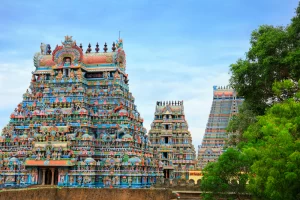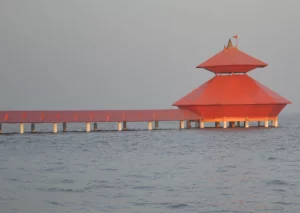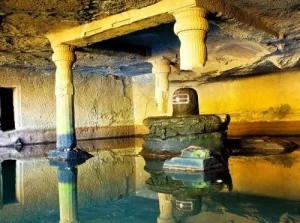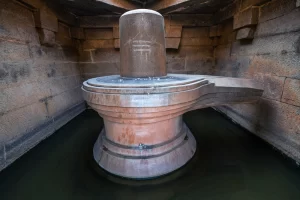Shiva Linga is also known as the lingam, ling, or Shiv ling in water. It is the symbol of the most significant Hindu God, Lord Shiva, in temples to worship. Hindu believers worship Shiva Lingam as a representation of the power and energy of God. The people consider Shiva linga as Shiva himself. Shiva lingam is always represented with the yoni, a symbol of Mata Shakti (female creative energy). It symbolizes the unique indivisible power of the male and female means lingam and yoni, which originates all the lives.
Shiva Linga’s oval shape resembles the whole Universe, and its bottom reaches the base of Supreme Power which holds the entire Universe.
Why does Shivling need water?
The pouring of water came from the ancient tale of Samudra Manthan when Devatas and Asuras were churning the oceans to claim the spoils. Finally, ‘Halahal’ poison came out of the churning, the most potent venom capable of killing both Asuras and Devatas. Lord Shiva drank the poison to save the world from damnation and kept it in his throat. Shivji knew only he could tolerate the heat of the poison. Shiv Ji stopped that venom flow through his throat. After this, his body began radiating because of the heat generated by the venom.
Then as per Vishnuji’s orders, all the devs and demons started pouring cold water on Shivji, and he got relief.
This poison produced so much heat that the Devtas performed Ganga Abhishek on lord Shiva and poured waters of Ganga in massive amounts on Lord Shiva.
Following that incident, pouring cold water or any other cold substance became a ritual present. This poison remains in the throat of Shivji, and for this, he was given a new name, ‘ Nilkanth,’ which means someone with a blue throat.
Top 5 Shiv Ling In Water Temple
1. Gangeshwar Temple

Gangeshwar Mahadev Temple is an Ancient Hindu Temple dedicated to Lord Shiva, and this Temple has located 3 km from Diu in the Fudam Village of Gujarat. This Temple was built by five Pandav brothers, Yudhishthira, Bhima, Arjuna, Nakula, and Sahadeva, during the period of Mahabharata, and this Temple is 5000 years old. This Temple is famous for its five Shiva Lingas, i.e., rocks in the shape of Lord Shiva, which are present on the surface of the sea. These links are generally submerged in the sea during high tides, and only during the low tides do they chance to be visible. This Temple is called the ‘Seashore Temple’ as Shiv Ling in water is situated on the seashore.
2. Jambukeswarar Temple

Jambukeswarar Temple is a famous Shiva temple in the Tiruchirapalli district in Tamil Nadu. The Temple was built by Kochenga Chola, which is 1,800 years old and has inscriptions from the Chola period. This Temple is on Srirangam island, also famous for the Ranganathaswamy temple in Tamil Nadu. Thiruvanaikal is one of the five major Shiva Temples of Tamil Nadu, representing the five outstanding elements. This Temple represents the component of water or neer in the Tamil language. The sanctum of Jambukeswara has a shiva lingam in water stream, and despite pumping water out, it is always filled with water.
3. Stambeshwara Mahadev Temple

Stambheshwar Mahadev Temple is an ancient temple located in Kavi Kamboi in Gujarat. The Temple is between the Arabian Sea and the Bay of Cambay in Gujarat. Stambheshwar Mahadev Temple, also known as the Submerging Temple and this Temple is 150 years old. Bhagwan Kartik established this Shiv Ling after killing Tarkasur. This Shiva lingam in water is unique that it can be seen only during low-tide hours, and at high tide, it disappears, and it is called the “disappearing temple of Mahadev.”
4. Kedareshwar Cave Temple

Kedareshwar Cave Temple is located at Harishchandragad, a hill fort in the Ahmednagar district. A Kedareshwar Cave Temple is different from other temples. It is situated in a cave, and the presence of water all year round makes the Temple one of the unique temples in Maharashtra and India. A Shiva Linga of about five feet is situated at the cave’s center. One has to wade through waist-deep and ice-cold water to reach the Shiva Lingam in water. Four pillars surround the Linga, and now only one pillar is intact. Some believe the pillars symbolize yuga or time, namely, Satya, Tretha, Dwapara, and the Kali Yuga. The present pillar is said to represent the last and final yuga, which is the present one, the Kali Yug. The walls of the cave are filled with sculptures and carvings.
5. Badavilinga Temple

The Badavi Linga Temple is beautiful in Hampi and dedicated to Lord Shiva, and it is located near the Lakshmi Narasimha Temple in Hampi. The Shiva Lingam is situated in the midst of the Temple, surrounded by water on all sides. Badavilinga Shiv Temple is the largest monolithic Linga, and the monolithic Shiva Linga is 3 m in height. Badavilinga Temple Shiv Linga is made up of black stone. The Shiva Lingam in water has a large circular pedestal. Water oozes out regularly from the foot level and is always three feet deep. For that, Lingam is half in water and half above the water level.
